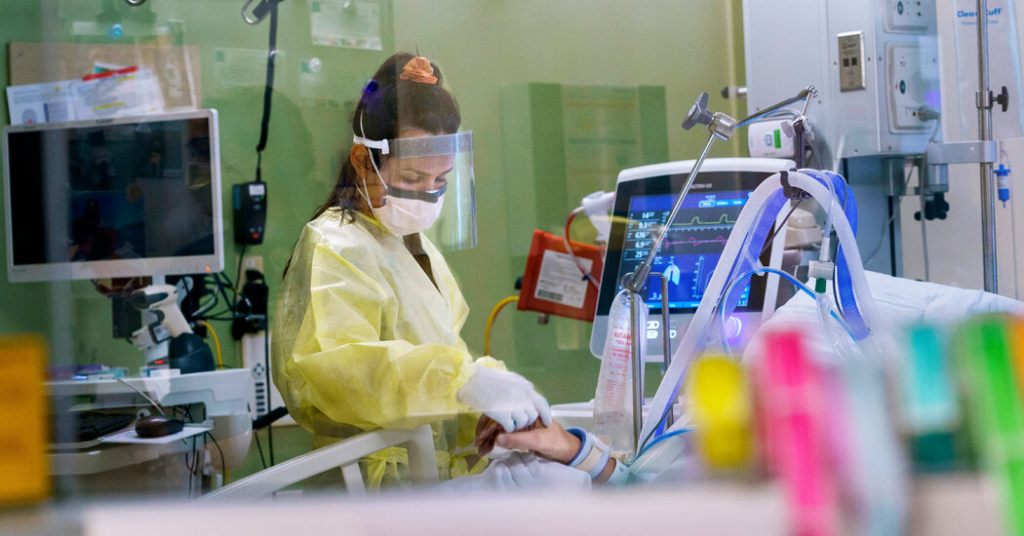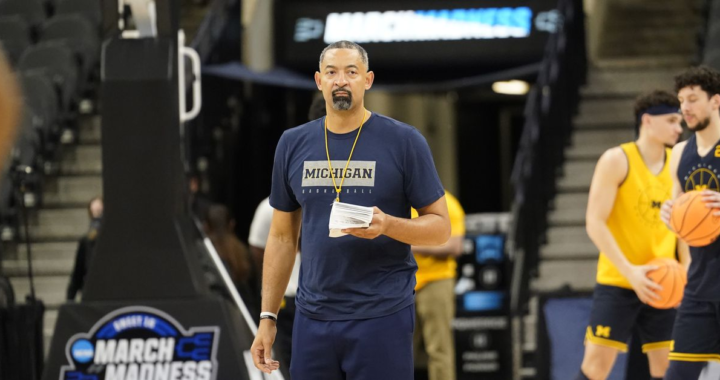Facing Its Worst Virus Surge, Oregon Adopts Nation’s Toughest Restrictions
6 min read
PORTLAND, Ore. — Facing a 990 percent increase in coronavirus hospitalizations since July 9, Oregon leaders have deployed the National Guard to hospitals, dispatched crisis teams to the hardest-hit regions of the state and ordered educators and health care workers to get vaccinated or lose their jobs.
Now, in her latest mandate that will take effect on Friday, Gov. Kate Brown has gone beyond what any other state has done in battling the summer surge, requiring that both vaccinated and unvaccinated people wear masks when gathering closely in public, even when outdoors. She said more restrictions might be needed as the coming days unfold and the state tries to keep in-person schooling on track.
“All options are on the table,” Ms. Brown said in an interview this week.
Oregon’s aggressive approach in restoring pandemic mandates is a stark divergence from states in the South, where outbreaks have been even worse but where many governors have resisted mandates for masks and vaccinations. But with the arrival of the Delta variant, Oregon has become one of a handful of states where cases and hospitalizations have escalated beyond even the records set during the worst part of the pandemic last year.
The virus is rampaging through rural communities where vaccination rates remain low. Hospitals across the state are near capacity, almost 50 percent beyond the state’s previous peak in December. Last week, a coronavirus patient in Roseburg died while waiting for an I.C.U. bed.
The Oregon Health Authority director, Patrick Allen, said the situation was so “dire” that he was urging unvaccinated people to avoid engaging in any nonessential activities.
“It’s that simple. It’s that urgent,” he said.
Yet as the country debates how far to go with new mandates, the lines between what is safe and what is not are becoming less clear. While she said she was ruling nothing out, Ms. Brown has not imposed the kind of restrictions that were in place when the virus was less virulent than it is now; she has not prohibited indoor dining or large public gatherings, and the state is resuming in-person instruction at most public schools, unless they face serious outbreaks.
That has largely left local leaders and businesses — and individuals themselves — to figure out how to navigate the hazardous new terrain.
In the state’s largest city, Portland’s mayor, Ted Wheeler, was among those to embrace new mandates on face coverings this month when Ms. Brown required them for indoor activities, including for those who are vaccinated. “Please join me in making a commitment to protect those around us by wearing a mask at all times while indoors,” Mr. Wheeler urged on Twitter.
But, a week later, on Aug. 20, Mr. Wheeler gathered with others in the eighth-floor lounge of a downtown hotel, joining a send-off party for a departing staff member. Photos obtained by The New York Times show him sitting with about a dozen people — almost all unmasked — testing the limits of the strict new mask rules.
Lennox Wiseley, a spokeswoman for Mr. Wheeler, said the mayor and his staff were complying with the rules because they were “actively eating and/or drinking” — the state standard at which people can remove their masks indoors.
Guests at the Nines hotel, where the gathering took place, usually wear face coverings but can take them off in the lounge to eat or drink, said Bernard Philippe, general manager of food and beverage. But he acknowledged that it could be a challenge for staff members to gauge precisely when masks should be worn.
“It’s hard for the server to make any of those distinctions,” Mr. Philippe said.
Ken Stedman, a biology professor at Portland State University who studies viruses, said that while Mr. Wheeler’s group seemed to be spaced apart, he had some concern about the gathering.
“I would prefer to see more masks on,” Dr. Stedman said.
Ken Henson, who co-owns Pelican Brewing, which has locations along the Oregon coast, said the strictest interpretation of the rules was that people should wear masks and pull them down only to take a bite of food or a sip of a drink. But, in practice, he said, his restaurants allow customers to remove their masks once their food or drinks are in front of them.
Even among people who have been generally compliant, he said, some customers are growing wary and unwilling to stay on board.
“The underlying tension is people are just tired,” Mr. Henson said.
Some places have resisted Ms. Brown’s orders. Redmond’s school board, upset about the statewide requirement that teachers be vaccinated and students wear masks, adopted a resolution on Wednesday night calling for local control over such issues.
Other localities, however, have talked about going even further than the governor. In Washington County, just outside Portland, commissioners considered a ban on indoor dining. Kathryn Harrington, the chair of the county board of commissioners, said the board eventually elected not to impose such a ban after getting advice that it would have little effect unless other counties joined in. Instead, the county elected to step up enforcement of mask requirements.
Ms. Harrington said she personally did not plan to attend events for the foreseeable future.
“I am just not going to be taking any risks with anybody else’s health,” Ms. Harrington said. “It’s really hard to not see my friends right now. Really hard. But it’s the right thing to do to limit our gatherings with one another.”
Until the latest surge, Oregon had endured much of the pandemic as a success story. Among states, it ranks 46th in coronavirus deaths per capita.
Throughout much of last year, Ms. Brown maintained some of the most stringent restrictions in the nation and eased them later than many other states did.
But although many Oregonians embraced vaccines, those who live in the more populated parts of the state were more inclined to get one. In some counties, only about one-third of residents are vaccinated, creating fertile territory for the spread of the Delta variant. By July, case numbers in the state started to rise dramatically.
Oregon is now recording more cases each day than at any point in the pandemic, and hospitalizations, now averaging 968 a day, have reached a new peak.
Health care workers in Portland pleaded for action at a news conference this week. Levi Cole, an I.C.U. nurse at Portland Providence Medical Center, said he had measured the ages of some of the people he has recently put into body bags: 20, 37, 42, 45, 52.
“The enemy has gotten meaner, and society as a whole sort of let its guard down,” Mr. Cole said. “We are all pretty overwhelmed and pretty exhausted and are running out of the available will and faith in society to do its part.”
Ms. Brown, in the interview, said part of the challenge in states such as Oregon that largely contained the virus early in the pandemic was little natural immunity in the population, allowing the more contagious variant of the virus to run rampant.
The Delta variant began sweeping across the country just after Ms. Brown eased the last remaining restrictions at the end of June. Dr. Renee Edwards, the chief medical officer at Oregon Health & Science University, said the timing of the variant’s arrival was unfortunate. To prevent the crisis the state is now in, she said, the state would have had to return to serious restrictions at least two weeks ago.
New mandates may not help much now, she said, and projections show that cases are likely to reach a peak sometime next week, with or without them.
To help curtail the virus, she said, it is important for people to consider voluntarily restricting activities such as going to restaurants and attending concerts, especially if they are unvaccinated.
“It is hard to get people back into a mandate mind-set again when they were feeling the freedom of summer,” Dr. Edwards acknowledged.
Ms. Brown said the most draconian restrictions of last year — such as closed restaurants and limited gatherings — were unlikely to be as necessary this time around since there were easy and effective tools available: masks and vaccinations.
“If we continue to mask up and get vaccinated,” she said, “we know that these tools will save lives and keep our schools, businesses and communities open.”





